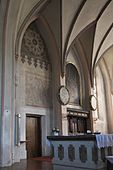St. Rupertus (Eiselfing)
The Catholic parish church of St. Rupertus in Eiselfing , a municipality in the Upper Bavarian district of Rosenheim , was built at the end of the 15th century with the inclusion of a Romanesque predecessor building. Gothic wall paintings that were discovered during renovations in 2008 have been preserved in the choir . The church is consecrated to St. Rupert , the first bishop of the Salzburg diocese , to which Eiselfing belonged until 1817.
history
The church of Eiselfing is mentioned in writing for the first time in a document of the Salzburg Archbishop Eberhard II from the year 1205 as a baptistery . Between 1250 and 1300, the walls of the Romanesque nave were raised to the height of the current nave. At the end of the 15th century, the church was presumably redesigned in the late Gothic style by Wolfgang Wiser , a master builder proven in Wasserburg am Inn . In the years 1859/60 the nave was extended to the west by one and a half bays to enlarge the gallery .
architecture
Exterior construction
The substructure of the bell tower goes back to the Romanesque predecessor church. The pointed arch frieze is dated to the 15th century. The original crowning of the tower was replaced by a pointed helmet in 1749. After a lightning strike in 1800, the tower received its current cranked double onion hood .
The neo-Gothic west entrance was laid out after the nave was extended in 1859/60. A banner and three Gothic keystones of uncertain origin, which date back to the 14th century, were placed above the portal . A bearded head of Christ with a cross nimbus is depicted on one keystone, a lion and a mythical creature on the other two. The banner bears the inscription "He should build me a house and I want to fortify his richly" (7.13 LUT ), a passage from the 2nd book of Samuel .
inner space
The church is designed as a hall . The retracted, axially shifted choir is closed on three sides. The choir and nave are covered by a reticulated vault, the ribs of which rest on staggered pillars and sculpted consoles .
Wall painting
A fresco of a crucifixion group , which is dated around 1350, has been preserved in the choir . Under the cross, which is depicted as a forked cross , Mary , Johannes and a bishop, probably St. Rupert, can be seen. Above this scene, under the pointed arch, is the face of a Gothic clock. The painting dates from around 1500.
Pietà
The Pietà by Ignaz Günther on the left side altar is considered the most important work of art in the church. The Vespers picture was originally created for the Attel Rosary Brotherhood and placed on an altar in the church of the former Benedictine monastery of Attel . After the secularization of the monastery, the picture was sold and came into the possession of the parish church of Eiselfing in the course of the 19th century. The sculpture group bears the signature of the sculptor "Ign: Günder" on the back and is marked with the year 1758. During the restoration in the 1990s, the original color scheme was restored.
Roman grave altar
During the church renovation in 1969, a Roman grave altar was discovered that was walled up in the cafeteria of the former high altar . The altar made of light, yellowish red limestone of the type of a pillar tomb is dated between 200 and 250 AD. A Latin inscription is chiseled on the front and bas-reliefs are engraved on the narrow sides.
Further equipment
- Two panels of a late Gothic altar wing from 1509 are integrated into the tabernacle on the main altar. St. Florian and St. Cordula are depicted on them.
- Twelve brotherhood poles are set up on either side of the main altar . The poles of the Brotherhood of the Names of the Virgin Mary are decorated with symbols of Mary , the poles of the Seven Refuge Brotherhood are decorated with Eucharistic symbols such as the chalice and the host.
- The grave inscription on a faience plate from 1496 above the sacristy door commemorates the priest Vinzenz Posch the Elder.
- On a tombstone fragment made of red marble, Vinzenz Posch the Younger is depicted as a priest with a biretta and chalice. It is dated around 1550.
literature
- Georg Dehio : Handbook of German Art Monuments - Bavaria IV - Munich and Upper Bavaria . 2nd edition, Deutscher Kunstverlag, Munich 2002, ISBN 3-422-03010-7 , pp. 241–242.
- Ferdinand Steffan: The churches and chapels of the parish Eiselfing . Published by the Catholic Parish Office St. Rupertus Eiselfing, Wasserburg 2011.
Web links
Individual evidence
- ↑ For the second time in the State Office: The Eiselfinger Pietà by Ignaz Günther. Examination of the sculpture in the workshops of the State Office for Monument Preservation, Bavarian State Office for Monument Preservation (accessed on July 23, 2016)
Coordinates: 48 ° 2 ′ 27.8 ″ N , 12 ° 14 ′ 36 ″ E







